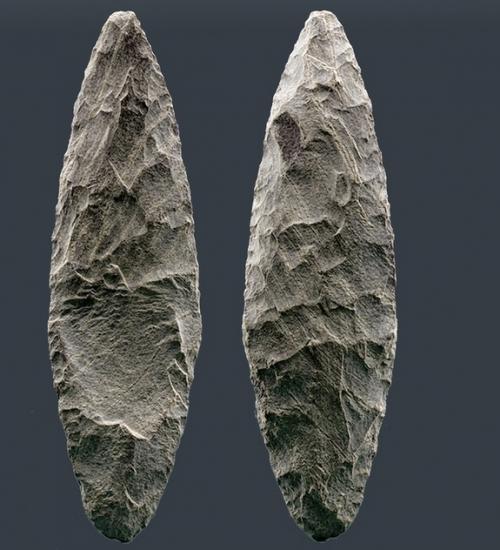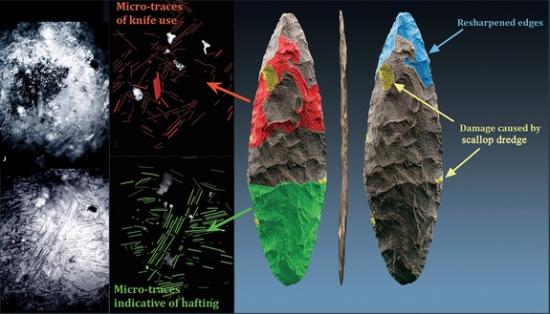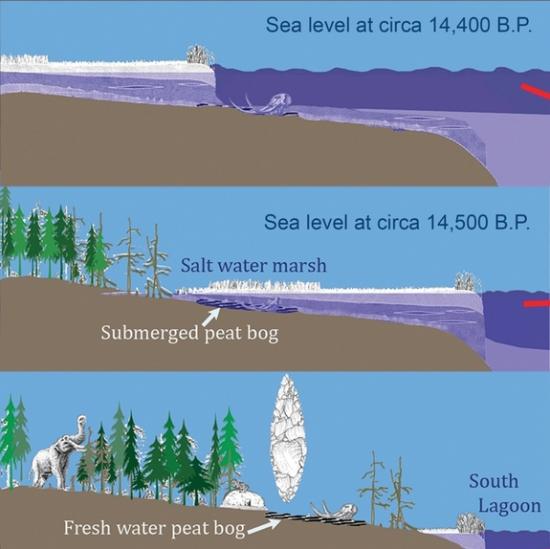Tia Ghose
Source - http://www.livescience.com/47289-mastodon-found-under-chesapeake-bay.html

A flaked blade unearthed from the Chesapeake Bay along with a mastodon skull shows evidence of weathering in open air, then saltwater marshes, and finally the ocean. Because sea levels submerged the area about 14,000 years ago, the weathering suggests that the tool was made at least that long ago, and that people may have been living on the Atlantic Coast at that time Credit: Dennis Stanford
A 22,000-year-old mastodon skull and tool dredged from the seafloor in the Chesapeake Bay hints of early settlers in North America.
The two relics, which were pulled up together, may come from a place that hasn't been dry land since 14,000 years ago. If so, the combination of the finds may suggest that people lived in North America, and possibly butchered the mastodon, thousands of years before people from the Clovis culture, who are widely thought to be the first settlers of North America and the ancestors of all living Native Americans.
But that hypothesis is controversial, with one expert saying the finds are too far removed from their original setting to draw any conclusions from them. That's because the bones were found in a setting that makes it tricky for scientists to say with certainty where they originated and how they are related to one another.
"The bottom line is, there simply is no context for these discoveries," said Vance Holliday, an archaeologist at the University of Arizona in Tucson, who was not involved in the study.

Used knifeCredit: Dennis Stanford The tool may have been used to butcher an animal -- possibly the mastodon found. Microstriations and wear shown are typical of tool use.The sharp crisp edges suggest it wasn't tumbled in the surf or carried by water. Either way, the wear on the tool suggests it was on dry land at some point and then buried by sea water, which means the tool was older than 14,000 years old. That would mean people (and possibly migrants from Europe) lived on the Atlantic Coast prior to the Clovis culture
Deep-sea fishing

Before glaciers rose around 14,000 years ago, the area where the tool and skull were dredged was dry land. But rising sea levels turned the area into abog, then a saltwater marsh, before the waters may have completely submerged the items.
Most researchers believe the first Americans crossed the Bering Straitfrom Siberia about 15,000 years ago and quickly colonized North America. Artifacts from these ancient settlers, dubbed the Clovis culture after one of their iconic archaeological sites in Clovis, New Mexico, have been found from Canada to the edges of North America.
But in 1974, a small wooden scallop trawler was dredging the seafloor, about 230 feet (70 meters) below the sea surface and nearly 60 miles (100 kilometers) off the coastline in the Chesapeake Bay.
"They hit a snag, or a hang, as they like to say, which meant that something pretty heavy was in their net," said Dennis Stanford, an archaeologist with the Smithsonian Institution in Washington, D.C., who has analyzed the find.
When they pulled up their net, they found the partial skull of a mastodon, a distant cousin of the woolly mammoth that began its slide into extinction about 12,000 years ago, Stanford said. The fishermen also noticed a flaked blade made of a volcanic rock called rhyolite.

Tumbled surf edgeCredit: Dennis Stanford Here, a similar tool is shown with edges that were blunted by the surf.
Rediscovered treasure
The fisherman couldn't lug the skull back to shore in their tiny wooden boat, so they sawed off the tusks and teeth, tossed the rest overboard and eventually handed portions to the crew as souvenirs. Capt. Thurston Shawn gave the remaining tusk portions, teeth and knife to a relative, who donated the remains to Gwynn's Island Museum in Virginia. There they sat, unnoticed, for decades.
But while doing his doctoral dissertation, Darrin Lowery, a geologist at the University of Delaware, noticed the teeth and the tusk at the museum, and said, "Ooh, it's something Dennis would be real interested in," Stanford told Live Science.
By measuring the fraction of radioactive carbon isotopes (elements of carbon with different numbers of neutrons), the team found that the mastodon tusk was more than 22,000 years old.
There was no way to date the blade precisely, but the deft flint-knapping technique used to make it was similar to that found in Solutrean tools, which were made in Europe between 22,000 and 17,000 years ago.
Melting glaciers raised sea levels and submerged that area of the continental shelf about 14,000 years ago, so the knife must have been at least that old, Stanford added.
In addition, both pieces showed characteristic weathering that indicated they were exposed to the air for a while and then submerged in a saltwater marsh, before finally being buried in seawater.
That finding suggested that the two artifacts were possibly from the same environment — such as the marshes found between sand dunes that are often set back from the seashore. That would have been a perfect place for mastodons to find food, Stanford said.
"They like to chew on bushes and more rough shrubbery," Stanford said.
To Stanford, Lowery and their colleagues, the discoveries suggest that people lived along the East Coast more than 14,000 years ago — potentially thousands of years before the Clovis culture emerged there. These first American colonizers may have even crossed the Atlantic Ocean from Europe, Stanford said.
Pre-Clovis Americans?
"I think it's very convincing," said Michael B. Collins, an anthropologist at Texas State University in San Marcos, Texas, who was not involved in the current work.
The weathering on both items — first with open air, then saltwater, then seawater exposure — would be almost impossible to get without them having been on land prior to rising sea levels toward the close of the Pleistocene Epoch, which lasted from 1.7 million to 11,700 years ago, Collins said.
But the person who wielded the rhyolite knife may not have hunted the mastodon, Collins said.
"Those things could have come to rest there together at different times," with the tool possibly being 18,000 or 19,000 years old, Collins told Live Science.
The idea that the first Americans were European "has been around for a long time, and it's a tough case to make," Holliday said.
A 2007 study in the journal PLOS Genetics tied all living Native American populations to ancestors that crossed the Bering Strait from Siberia. If Europeans did reach the Americas 18,000 years ago, they left little genetic trace in living populations.
"There's absolutely no DNA evidence," Holliday said.
Archaeological evidence is also scarce. A few East Coast sites, such as Cactus Hill in Virginia and Meadowcroft Rockshelter in Pennsylvania, may have been inhabited up to 16,000 to 18,000 years ago, but the dating and provenance of artifacts from the sites are debatable, Holliday said.
Either way, it's impossible to know how the mastodon tusk and knife are connected, Holliday said.
"You would have to demonstrate that the artifact was associated with the mastodon — in the same geologic layers," Holliday said.
But many other fishing boats could have come and mixed up the sediments at the ocean floor prior to the scallop trawler's dredging. And with thousands of years of ocean currents, the artifacts could have originated in different locations. For all anybody knows, an ancient fisherman could have dropped the knife from a canoe 8,000 years ago, Holliday said.
The new discovery was described in May in a chapter of the book "Prehistoric Archaeology on the Continental Shelf" (Springer, 2014), though it has not been published in a peer-reviewed journal.